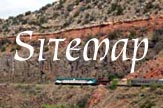(Click on the pictures below to obtain larger images, which take longer to download.) Photographs © George P. Landow may be copied without written permission for any noncommercial use — for hobbies, education, and so on. If you have any additional information on the locomotives or rolling stock in these pictures, please feel free to send it along to me at george@landow.com; pictures are welcome, too. GPL)

This tourist line originally served a large copper mining and smelting operation that left behind a gigantic black slag pile four stories high and hundreds of yards long. It supposedly contains so much remaining copper and gold — the side facing the tracks has large patches of oxidized copper green — that someone has bought for reprocessing. According to the history of the mine and railroad in the John Bell Museum (a room adjoining the gift shop) the original owner of mine, smelter, and railroad was such a right-wing conservative that, refusing to work for a Democrat, he shut down everything and eventually moved to Canada after FDR became president.



Left: The railroad logo. Middle left: A crew member — the engineer? — boarding the engine, an General Motors Electromotive Division FP7, originally owned by the Alaska Railroad. Middle right: The locomotive bears this eagle because, as the railroad brochure explains, Verde Canyon is "home of America's symbol, the bald eagle." Right; The first-class car in which we made the trip.



Left two: the picnic area next to the tracks. Right: An old wood-and-metal mine car that used to carry explosives.
Photos from the Observation Car

The locomotive approaching the bend in the midst of an s-curve.


Left: Pulling across a deck bridge supported by a steel trestle. Right: a caboose preceded by one of the open observation cars that were placed between every two cars. George found these much better than the one on the Eastern and Oriental Express. The one on the E&O has a roof on that covered the entire car, making it difficult to photograph anything above the train; this one provided opportunities for both shade and good viewing angles.


Left: As we reached midpoint in the journey, we arrived at Perkinsville, a deserted town with a partially destroyed watertower and a repair shed. According to Wil, although this stop was named after the Perkins, who owned a nearby farm, the railroad was only extended here to ship limestone needed in the smeltering opperations. Right: the old train station, one typical of small stations in the southwest.


The double-ended locomotive heads to the former rear of the train on the branch track. Right: The brakeman in the cab as the engine pulls to the new front of the train. When he came walking back a few moments later, one of the passengers in the observation car who had heard what he thought was an odd sound and thought the brakeman was checking it out asked if there were anything wrong, and (having heard this many times) the brakeman replied, "I forgot where I parked it." Got a good laugh.


Left: Crossing a high narrow bridge. Right: Contrasting cliffs by which the train travelled.

Nature along the way

A bald eagle's nest with two birds in the nest.


Left: Middle: Cactus flowers. Right: On the way back the caboose was coupled behind to the locomotive instead of appearing at the end of the train.

The train crosses a deck bridge and trestle combination on the way home.


Left: A view of the river. Right: Trees by the river grow at an angle, presumably because of the winter wind.


